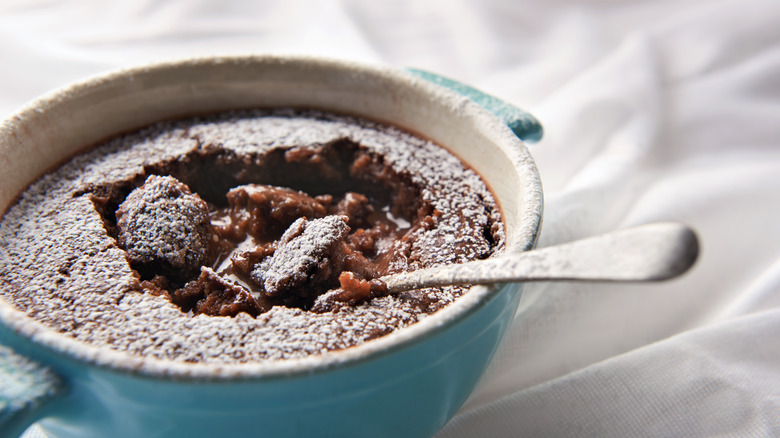What Gives Self-Saucing Pudding Its Name?
When you picture a self-saucing pudding, you might think of something like a flan with an erupting top layer of sauce — that is if you even get past wondering why a pudding might need a sauce at all. It's a strange name to ponder from all accounts until you remember that pudding can mean any number of cooked sweet treats by British and Australian definitions. Knowing that pudding can often be a kind of cake, the name self-saucing pudding might make more sense.
In Britain, a self-saucing pudding is a classic and almost traditional kind of dessert that involves a moist cake layer and a semi-eponymous luscious sauce. The name comes from the fascinating transformation that occurs during the baking process.
The cake batter bakes into a moist layer over the sauce, turning every forkful into a sauce-bathed morsel as you break through the surface. The best part is that self-saucing pudding doesn't require any complicated ingredients or baking know-how to float the cake layer and recreate the self-saucing effect. It's a classic homemade British dessert that you can probably make with the cake ingredients already in your pantry.
How is self-saucing pudding made?
For the most part, self-saucing pudding is made a lot like your classic cake recipe, with a small twist that adds the self-saucing effect. You make your pudding batter with flour, milk, butter, baking powder, sugar, and your choice of flavor — then, a liquid topping made of hot water, sweetener, and complementary flavors is carefully poured on top of the pudding batter. You'll want to pour the hot liquid over the back of a spoon as you're layering it over the pudding so as to minimize impact and disturb the batter as little as possible.
One of the most popular variations of a self-saucing pudding is the chocolate version, where cocoa powder is added to the pudding batter as well as the sauce. Generally, recipes will also instruct you to add a thin layer of cocoa powder over the batter before adding the hot sauce on top. Once you've settled the liquid layer on top, it's time to pop it into the oven to bake for around 30 minutes. Through the power of thermodynamics, the pudding batter at the bottom will actually rise to the top as it bakes and create a delicious surface over the indulgent sauce hidden underneath.
How is self-saucing pudding served?
For the best experience, self-saucing puddings are often served warm, straight out of the oven. Some enthusiasts pair it with some vanilla ice cream or a generous heap of freshly whipped cream, adding a cool and creamy element to the warm and saucy dessert. If you're a real chocolate lover, you can triple up on the decadence by topping the pudding with shaved chocolate or melted chocolate sauce. Some even enjoy pairing it with custard or pudding as we know it on this side of the ocean.
While chocolate is the most common kind of self-saucing pudding you'll find, this warm and delectable treat is by no means limited to chocolate lava cake-style desserts. You can also prepare it in other flavors, like lemon, with a fruity sauce underneath. Because of its deliciousness and big wow factor for relatively little effort, self-saucing puddings can also be made in individual servings of small bowls or ramekins to serve as an incredible crowd-pleaser at any kind of dinner party.


